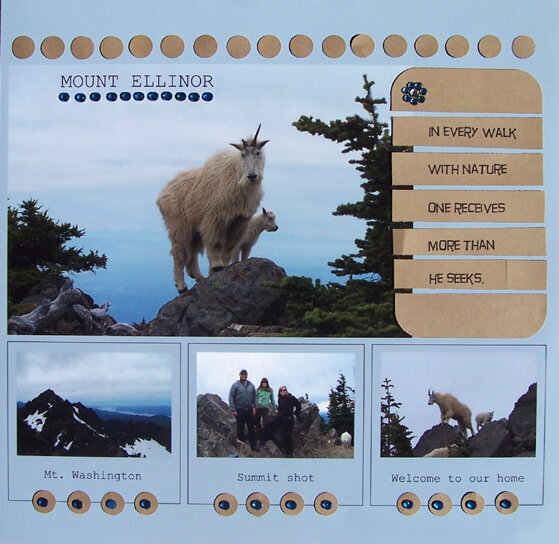

 Give a Cheer
Give a Cheer
The weather forecast did not look greatest for the weekend. We had Mt. Ellinor planned with a back up of staying along I-90 if we determine the visibility is bad enough and the long drive would not be rewarded with the gorgeous views this area has to offer. As the week progressed the forecast slowly changed to our advantage and we were excited to stick with our original plan and headed to Ellinor.
Even though it never completely clear, the clouds were high letting us enjoy variety of views from different points along the trail. It was my first time up there and despite the fact I've seen many pictures, being surrounded by this amazing scenery in person was truly breathtaking.
We decided to take a little break after we conquered the first part of the chute and while scanning the area I noticed this white spot on the rock wall behind us. Mountain Goat! And it had a baby… our short break suddenly turned into about 15 minute photo shoot of those two goats. It was so cool, we thought, and continued our way towards the summit. As soon as we reached the second false summit, there were another two goats (again it was mommy goat and her baby) walking down the trail in our directions. They were way closer that the goats we saw earlier and were not bothered by our presence at all. It was very obvious they will walk just past us… so we got our cameras ready, and snapped tons more pictures. At one point the goats were as close as about 5 feet from us, and even posed for us on rocks close by.
So cool, we though again and now with the true summit in our sight we braved the last part of the trail… just to notice more goats peeking at us from the top. There was a nice family of about 4 of them there, running around, kind of checking us up together with several chipmunks that entertained us by crawling up people's legs and jumping on people's shoulders in their attempts to steal our food.
The views were wonderful. We did not see Rainier or the other major peaks very clearly as they were hiding in a mist but there was so much more to look at and with all the wildlife around, we spend good 2 hours up there before we decided it was time to have some fun glissading down the chute.
Needless to say as soon as I got home I went online and googled “Mountain Goat” to learn more about the wonderful animals we saw. Among other things I found out that these large-hoofed mammal are found only in North America and despite their name, they are not true goats, as it belongs to the same family as antellopes and cattle.
They resides at high elevations and are a sure-footed climber, often resting on rocky cliffs that predators cannot reach. Their feet are well-suited for climbing steep, rocky slopes, sometimes with pitches of 60 degrees or more, with inner pads that provide traction and cloven hooves that can spread apart as needed. Dewclaws on the back of their feet also help to keep them from slipping. It was trully amazing to watch how fearlessly they climbed the cliffy summit area, even the babies had no problem with the steep pitch.
In the wild, mountain goats usually live twelve to fifteen years, with their lifespan limited by the wearing down of their teeth. In zoos, however, they can live for sixteen to twenty years.
The males are also called billies and females nannies. Kids are born in the spring (late May or early June – lucky us) after a six month gestation period. Nannies give birth, usually to a single offspring, after moving to an isolated ledge; post-partum, they lick the baby dry and ingest the placenta. Kids weigh a little over 3 kg (about 7 lb) at birth and begin to run and climb (or attempt to do so) within hours. Although they are mostly weaned within one month, kids follow their mothers closely for the first year of life (or until the nanny gives birth again, if this does not occur the next breeding season); nannies protect their young by leading them out of danger, standing over them when faced by predators, and positioning themselves below their kids on steep slopes to stop free falls. After the breeding season is over, males and females move away from each other, with the adult billies breaking up into small bands of two or three individuals. Nannies form loose-knit nursery groups of up to 50 animals.
Nannies can be very competitive and protective of their space and food sources. They will fight with one another for dominance in conflicts that can ultimately include all the nannies in the herd. Although they have gained notoriety for their shows of aggression, mountain goats spend most of their time quietly grazing. Their diet includes grasses, herbs, sedges, ferns, moss, lichen, twigs and leaves from the low-growing shrubs and conifers of their high-altitude habitat.
In captivity, the mountain goat's diet can also include grain, alfalfa, fruits and vegetables.
No products have been added to this project.
Thanks for spreading positivity!
July 28, 2011
December 08, 2008
December 08, 2008
September 09, 2008
August 31, 2008
August 29, 2008
August 29, 2008
August 28, 2008
August 28, 2008
August 28, 2008
August 14, 2008
August 04, 2008
July 19, 2008
July 12, 2008
July 12, 2008
July 08, 2008
July 04, 2008
July 04, 2008
July 04, 2008
July 04, 2008
June 30, 2008
June 30, 2008
June 30, 2008
June 30, 2008
June 29, 2008
June 29, 2008
June 29, 2008
June 29, 2008
June 29, 2008
June 29, 2008